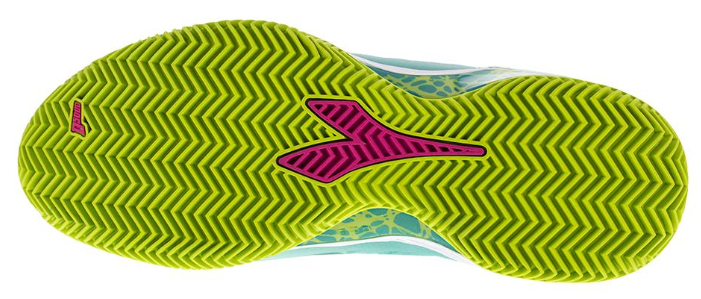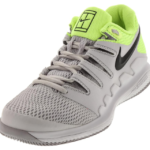Based off of our unique builds, foot types, and general preferences, we all have certain features that we look for in a shoe. Larger and taller players may need additional support, while smaller players might gravitate toward something lighter weight. Similarly, some people prefer a wide shoe, and others prefer a narrow shoe. Once all of these factors have been taken into account, tennis players in particular must then consider their playing surface.
Hard Court Tennis Shoes

 “Soft” or “padded” concrete is the most frequently played on surface in tennis; unfortunately, it can also be the most challenging on a player’s foot. There are a variety of reasons for this, and hard-court shoes take each of them into account. For example, because of the lack of give on this type of surface, shoes must have excellent cushioning. They must also provide suitable support because of the particularly sharp changes in direction needed. Finally, the tread patterns and outsole materials used must be specifically selected for optimal performance on hard surfaces.
“Soft” or “padded” concrete is the most frequently played on surface in tennis; unfortunately, it can also be the most challenging on a player’s foot. There are a variety of reasons for this, and hard-court shoes take each of them into account. For example, because of the lack of give on this type of surface, shoes must have excellent cushioning. They must also provide suitable support because of the particularly sharp changes in direction needed. Finally, the tread patterns and outsole materials used must be specifically selected for optimal performance on hard surfaces.
Featured is the Diadora Women’s S Blueshield AG Tennis Shoe in Aruba Blue and Ceramic
Clay Court Tennis Shoes

 Clay courts are another beast entirely, which is why companies provide shoes that are specially designed to meet these unique challenges. Clay courts allow a sort of slide when players change directions. As a result, clay court tennis shoes can be a little bit more lax with their lateral support. That being said, the fine grains of dirt associated with clay surfaces can get into your shoes and bother your feet, which is why many clay court shoes have a more solid upper (typically composed of dense mesh, leather, or a synthetic material). Clay court tennis shoes also come with specialized outsoles.
Clay courts are another beast entirely, which is why companies provide shoes that are specially designed to meet these unique challenges. Clay courts allow a sort of slide when players change directions. As a result, clay court tennis shoes can be a little bit more lax with their lateral support. That being said, the fine grains of dirt associated with clay surfaces can get into your shoes and bother your feet, which is why many clay court shoes have a more solid upper (typically composed of dense mesh, leather, or a synthetic material). Clay court tennis shoes also come with specialized outsoles.
Featured is the Diadora Women’s S Blueshield Clay Tennis Shoe in Aruba Blue and Ceramic
More About Clay Courts
There are a number of different clay courts out there that you can differentiate by color. The various colors of the clay courts means they’re made of different materials.
- Red clay courts are made of crushed brick and shale
- Green clay courts use crush basalt
- Blue clay courts are made from crushed brick
- Grey clay courts are made from natural clay from the ground
This effects how the ball spins and is returned. The red clay favors the player who can play defense, not one who can blow it by their opponent. On clay courts, the bounce is higher and slower than on hard courts. Additionally, players can slide into their shots on clay courts, which preserves energy. On hard courts, players are forced to come to a complete stop while hitting their return.
For More on Tennis Shoes
To learn more about tennis shoes, we encourage you to check out some of our other informational blogs:





